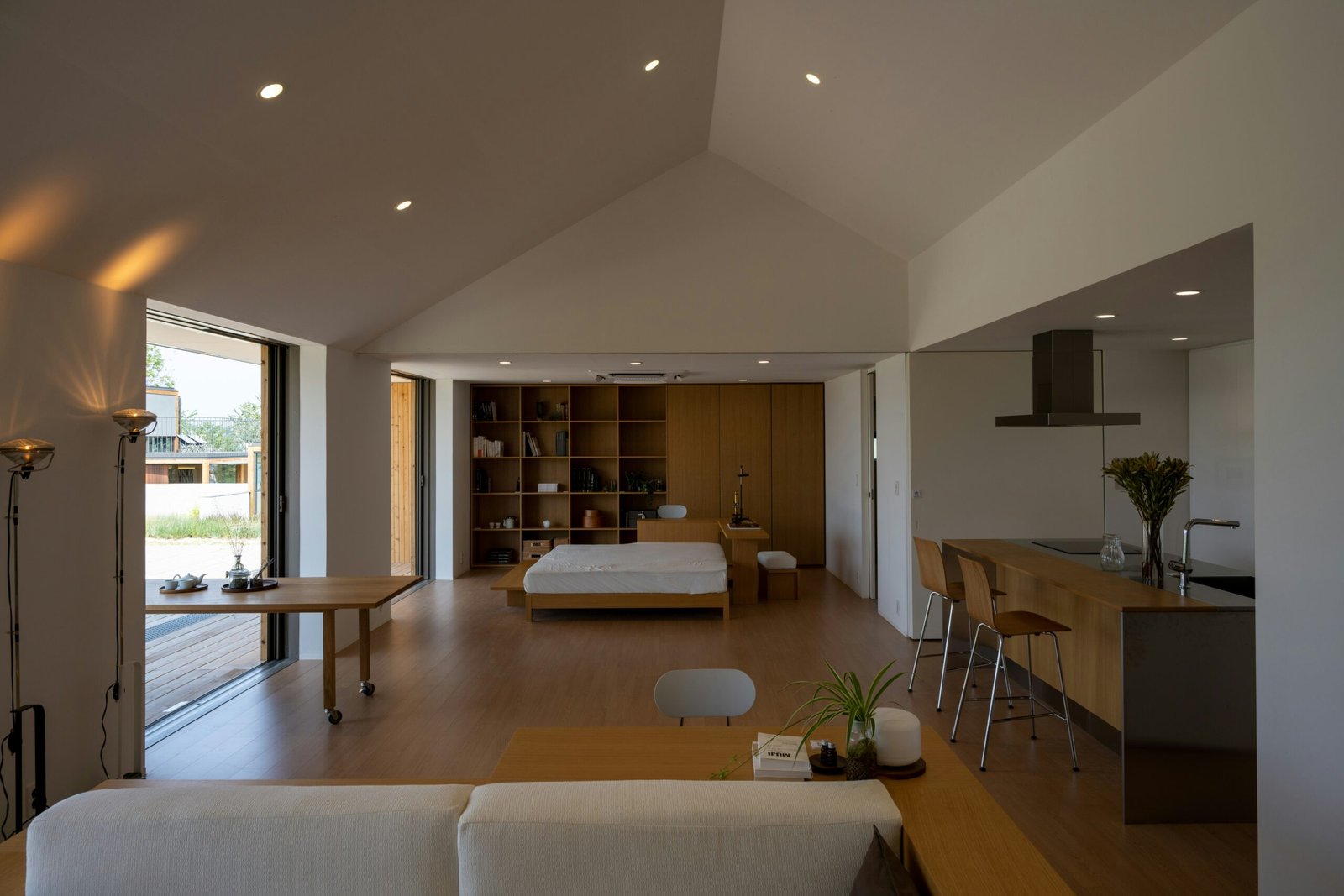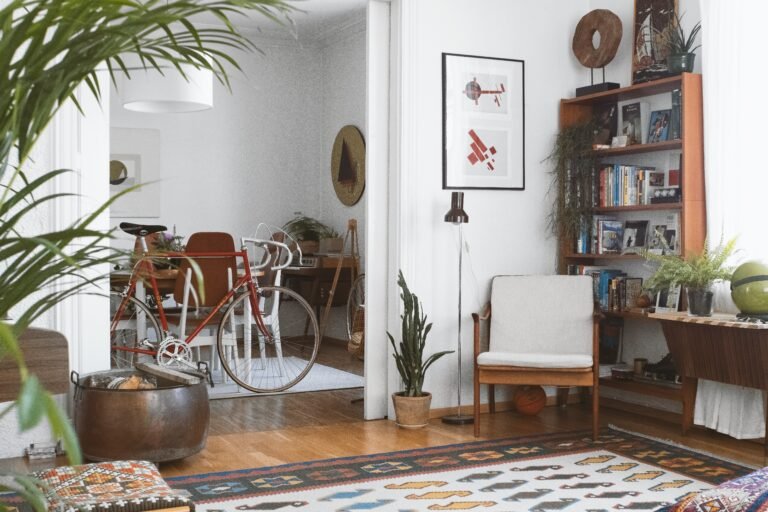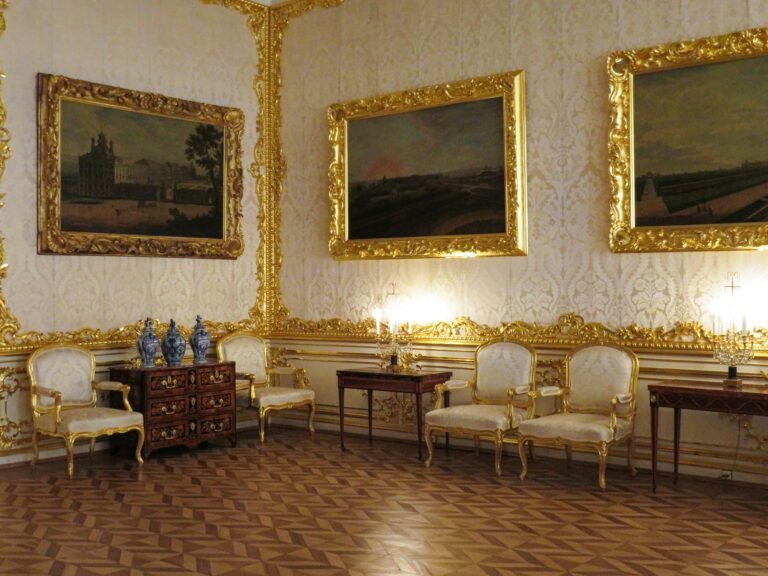In the world of interior design, Japandi vs Grandmillennial is one of the most fascinating comparisons. These two styles could not be more different at first glance, yet they both capture the attention of homeowners looking for spaces that reflect not only their taste but also their personality. While Japandi design embraces calm simplicity rooted in Japanese minimalism and Scandinavian warmth, Grandmillennial style celebrates nostalgia, comfort, and heirloom traditions in a fresh, updated way.
In my own home, I’ve experimented with touches of both. My balcony nook leans toward Japandi with a low wood bench, a neutral linen cushion, and a single potted bonsai that instantly calms the atmosphere. Meanwhile, my dining room carries hints of Grandmillennial charm with my grandmother’s floral china displayed proudly on open shelving. Living with these styles side by side has shown me just how powerful design choices can be in shaping mood, comfort, and identity.
In this guide, we’ll explore the history, defining features, and current interior design trends behind Japandi and Grandmillennial. You’ll see how they differ in materials, color palettes, and emotional atmosphere, and by the end, you’ll have the tools to decide which resonates with your own lifestyle—or even how to blend the two. This is more than a home décor comparison; it’s about finding the style that feels most like you.
What Is Japandi Design
Origins and Philosophy
Japandi design is a fusion of Japanese and Scandinavian aesthetics, combining the best of both worlds: the minimal, mindful approach of Japan’s wabi-sabi philosophy and the cozy functionality of Scandinavian hygge. The result is an interior style that feels both serene and warm, offering a space where every object has a purpose and nothing is excessive.
Architectural Digest describes Japandi as a “hybrid trend” that has gained global attention for its balance between simplicity and comfort. Its popularity surged in recent years, particularly during the pandemic, as people sought calming, uncluttered homes that also felt nurturing and lived-in.
Key Features of Japandi Interiors
Color Palette – Soft neutrals dominate, with whites, beiges, taupes, and muted grays creating a soothing foundation. Subtle contrasts—such as black accents or darker woods—are used sparingly to ground the space.
Natural Materials – Wood, bamboo, linen, cotton, and stone are central. These materials not only bring nature indoors but also connect to sustainability and longevity.
Low, Functional Furniture – Scandinavian clean lines meet Japanese low profiles. Furniture tends to be simple, practical, and timeless, with an emphasis on craftsmanship.
Decluttered Spaces – Japandi prioritizes quality over quantity. Instead of filling a room with decorative items, the focus is on a few carefully chosen pieces that bring beauty and meaning.
Mindful Details – From shoji-style sliding doors to textured ceramics, small touches celebrate imperfection and authenticity in line with wabi-sabi.
My Personal Experience with Japandi Design
When I began redesigning my living room, I leaned heavily into Japandi principles without even realizing it. I replaced a bulky TV stand with a low-profile oak bench, added a cream wool rug, and introduced a handmade ceramic vase from a local artist. The effect was immediate: the room felt lighter, calmer, and more intentional. Sitting there with a book and a cup of green tea became a ritual, not just a pastime. That’s the essence of Japandi—it transforms a home into a sanctuary.
What Is Grandmillennial Style
The Roots of Granny Chic
While Japandi is rooted in minimalist philosophy, Grandmillennial style celebrates the opposite: a joyful embrace of traditional patterns, heirloom pieces, and nostalgic touches. Often described as “granny chic,” the movement is a modern reinterpretation of classic décor that many millennials grew up with in their grandparents’ homes. Think floral wallpaper, chintz upholstery, needlepoint pillows, and ruffled lampshades—but refreshed with updated colors, sleek silhouettes, and curated restraint.
According to Homes & Gardens, this aesthetic is more than a passing fad. Designers see it as a bridge between old-world tradition and contemporary sophistication, where layering patterns and textures creates warmth without tipping into clutter.
Defining Features of Grandmillennial Homes
Patterns and Textiles – Florals, stripes, and damasks are combined confidently, often through wallpaper, curtains, and upholstery.
Heirloom and Vintage Pieces – Furniture with history—like mahogany dressers, wingback chairs, or antique side tables—anchors the space.
Decorative Details – Skirts, pleats, fringe, and ruffles appear in soft furnishings, but they are carefully balanced with modern accents.
Color Palette – Soft pastels, navy, emerald green, and muted pinks dominate, creating a warm and welcoming atmosphere.
Sentimental Styling – Family photos, china collections, or embroidered linens are displayed proudly, turning a house into a personal storybook.
How I Added Grandmillennial Touches to My Own Space
In my own dining room, I found myself leaning into Grandmillennial style when I inherited my grandmother’s china set. At first, I wasn’t sure how it would fit with my otherwise modern décor, but I decided to display it on open shelving alongside a patterned wallpaper backdrop. The result? A room that instantly felt cozier and more connected to my family history. Friends who visit often comment on how the space feels both stylish and deeply personal—proof that Grandmillennial is not about looking dated but about celebrating heritage with a modern twist.
Japandi vs Grandmillennial in Interior Design Trends
Popularity and Search Growth
In recent years, both Japandi and Grandmillennial have become standout interior design trends. Their rise has been fueled by shifting lifestyles, global events, and a renewed focus on how our homes make us feel.
According to RentCafe, Japandi emerged as one of the most searched-for styles in 2022, with its combination of Japanese minimalism and Scandinavian warmth resonating strongly with homeowners seeking calm, uncluttered environments. The search data reveals that Japandi is not just a niche aesthetic—it has become one of the defining global movements in design.
Grandmillennial style, meanwhile, reflects a different cultural shift. While Japandi embodies simplicity and mindfulness, Grandmillennial taps into nostalgia and comfort. In the wake of the pandemic, many people found themselves craving a sense of familiarity and warmth, leading to a resurgence of traditional décor elements—but in fresher, more curated forms. The popularity of patterned wallpaper, vintage furniture, and collected accessories is evidence of this trend’s lasting appeal.
Why Each Style Speaks to Today’s Homeowners
- Japandi Design appeals to those who prioritize calm, sustainability, and functionality. Its neutral palettes and natural textures help create a sanctuary where the outside world feels less intrusive.
- Grandmillennial Style resonates with those who value storytelling, heritage, and coziness. It offers a way to reconnect with tradition while still feeling stylish and relevant.
Together, these two trends demonstrate the dual desires shaping modern interiors: the need for peaceful minimalism and the longing for meaningful nostalgia. Depending on your personality, you might feel drawn more strongly to one side—or discover that a blend of both suits you best.
Japandi vs Grandmillennial: A Side by Side Comparison
When deciding between these two distinct aesthetics, it helps to break them down by their core elements. Each style has a clear identity, and understanding the differences makes it easier to see which aligns best with your home and personality.
Japandi vs Grandmillennial: Color and Material Palette
Japandi design favors soft neutrals—beige, taupe, ivory, gray—layered with organic textures like linen, stone, and natural wood. Occasional accents in black or deep earth tones provide grounding without overwhelming the space. The palette is intentionally subdued, reinforcing calm and clarity.
By contrast, Grandmillennial style thrives on color and pattern. Floral wallpapers, gingham curtains, and richly colored upholstery—navy, emerald, blush pink—bring vibrancy and character. Where Japandi whispers, Grandmillennial sings.
According to Wikipedia’s Japandi entry, this Scandinavian–Japanese hybrid design is praised for its harmony and timelessness, while Grandmillennial’s appeal lies in its bold embrace of nostalgia and decorative abundance.
Japandi vs Grandmillennial: Furniture and Decoration Choices
Japandi furniture is low, streamlined, and functional, often with natural wood finishes and little embellishment. A single, well-crafted dining table or minimalist sofa defines the room. Décor is sparse but intentional—ceramics, a bonsai, a woven rug.
Grandmillennial furniture, on the other hand, is often inherited or vintage-inspired: wingback chairs, mahogany dressers, or curvy sofas with rolled arms. Decoration is unapologetically abundant—china collections, embroidered cushions, and gallery walls brimming with family portraits.
Japandi vs Grandmillennial: Emotional Atmosphere and Personality Fit
Japandi feels like entering a spa—calm, uncluttered, and restorative. It appeals to those who value mindfulness, simplicity, and a space that allows the mind to rest.
Grandmillennial feels like coming home to a warm hug—nostalgic, sentimental, and full of personality. It resonates with those who cherish tradition, family history, and layered storytelling in their décor.
My Experience Comparing Both Styles
I noticed the difference firsthand in my own home. In my Japandi-inspired living room, I feel lighter and more focused—the clean lines and soft neutrals clear my head after a long day. But when I host friends in my Grandmillennial-style dining room, the patterned wallpaper and heirloom china spark conversation and laughter. Each room serves a different emotional purpose, and that’s the beauty of contrasting styles.
Which Style Fits Your Home and Personality
When it comes to Japandi vs Grandmillennial, the decision often reflects more than taste—it reveals how you want to feel in your home and how you express your personality. Let’s explore which style might be the best fit for you.
When Japandi Design Is the Better Match
Choose Japandi design if you:
- Crave calm and serenity in your home.
- Prefer fewer items of higher quality rather than lots of accessories.
- Enjoy a neutral color palette with natural textures.
- Value functionality and sustainability in your furniture choices.
- Seek a space that encourages mindfulness and simplicity.
For example, in my own bedroom, I replaced a cluttered dresser with a single low-profile oak chest. Paired with linen bedding in muted earth tones, the room instantly became a sanctuary where I sleep better and wake up refreshed. That’s the magic of Japandi—it supports your well-being by stripping away distractions.
When Grandmillennial Style Shines
Opt for Grandmillennial style if you:
- Love pattern, color, and layering.
- Feel nostalgic about heirlooms, vintage finds, or family traditions.
- Want your home to feel cozy, sentimental, and personal.
- Enjoy curating a space full of conversation-worthy pieces.
- Prefer warmth and richness over stark minimalism.
In my dining room, I leaned into this personality fit. A vintage mahogany table paired with floral wallpaper and my grandmother’s china turned the space into one of the most beloved rooms in my home. Every piece tells a story, and friends often linger there long after dinner is over.
Practical Tips for Choosing Confidently
Assess Your Lifestyle – Do you thrive in clean, uncluttered environments or in layered, eclectic spaces?
Start Small – Experiment in one room before committing house-wide. Try Japandi in your bedroom for calm, or Grandmillennial in a guest room for charm.
Mix and Match Cautiously – It’s possible to blend the two styles, but do so intentionally. For instance, start with a Japandi neutral base, then layer a Grandmillennial patterned throw or vintage armchair.
Stay Authentic – The right choice is the one that feels true to you. Interior design trends come and go, but a home that reflects your personality will always feel timeless.
Blending Japandi and Grandmillennial Elements
At first glance, Japandi design and Grandmillennial style seem like polar opposites—one minimal, the other maximalist. But in practice, there are ways to combine them to create a balanced home that feels both calming and character-rich.
Finding the Balance Between Minimalism and Nostalgia
The key to blending lies in proportion. Start with Japandi as your foundation: neutral walls, clean-lined furniture, and natural textures. Then introduce Grandmillennial accents carefully—a patterned armchair, a floral cushion, or an antique side table. This way, the warmth and nostalgia of Grandmillennial shine without overwhelming the serene Japandi base.
For example, in my living area I use a Japandi-inspired neutral sofa with oak legs, but I’ve layered in a vintage embroidered throw pillow from my grandmother. The contrast feels intentional rather than cluttered, and it sparks conversations while keeping the space grounded.
Examples of Harmonious Style Combinations
Living Room – Japandi low-profile sofa + Grandmillennial floral accent chairs.
Bedroom – Japandi linen bedding + vintage patterned wallpaper on one feature wall.
Dining Room – Japandi oak dining table + heirloom china displayed in a modern glass cabinet.
Entryway – Japandi shoe storage bench + antique mirror with an ornate frame.
Tips for a Cohesive Blend
Limit Patterns – Choose one or two statement Grandmillennial prints instead of many.
Stay in the Palette – Use muted or pastel versions of florals and stripes to keep harmony with Japandi neutrals.
Curate Accessories – A few heirloom pieces displayed intentionally can look chic, while too many risk clutter.
Layer with Texture – Woven baskets, linen curtains, and wooden accents help bridge the gap between sleek Japandi and decorative Grandmillennial.
Blending these styles successfully requires restraint. It’s not about making a 50/50 split, but rather allowing one style to lead while the other adds personality and depth.
Conclusion
Choosing between Japandi vs Grandmillennial is ultimately about more than following an interior design trend—it’s about creating a home that feels authentic to you. Japandi offers calm, simplicity, and functionality, while Grandmillennial celebrates nostalgia, tradition, and coziness. Both have strong emotional appeal, and both can transform your space into a reflection of your personality.
In my own home, I’ve learned that it doesn’t have to be an either-or decision. Japandi works beautifully in spaces where I want focus and rest, like the bedroom and living room. Grandmillennial, meanwhile, brings joy and sentimentality to my dining area, where gathering with friends and family feels enriched by its warmth. The lesson? Your home can be a mix of both worlds, tailored to how you want to live.
Whether you lean toward Japandi’s serene minimalism or Grandmillennial’s character-rich charm, the best design choice is the one that supports your lifestyle and makes you feel at home. Start small, experiment with details, and trust your instincts—your personality is the best guide for your style.
Frequently Asked Questions
Alex is the creator of Homely Haven, a space dedicated to simple, stylish ideas for interiors and gardens alike. With a passion for cozy living rooms, inviting outdoor spaces, and practical DIY solutions, Alex shares tips and guides that help turn any house into a true home.
From budget-friendly decorating hacks to weekend garden projects, the goal is always the same: to inspire you to create spaces that feel personal, beautiful, and welcoming. When not writing, Alex is usually rearranging furniture, sketching new garden layouts, or exploring design trends for the next project.








